Toyota Tuning
JDM Toyota 22R Tuning: Bringing Japanese Performance to Your Classic Engine
Navigate the exciting world of JDM Toyota 22R tuning and unlock hidden horsepower—discover the upgrades that can transform your classic engine today!
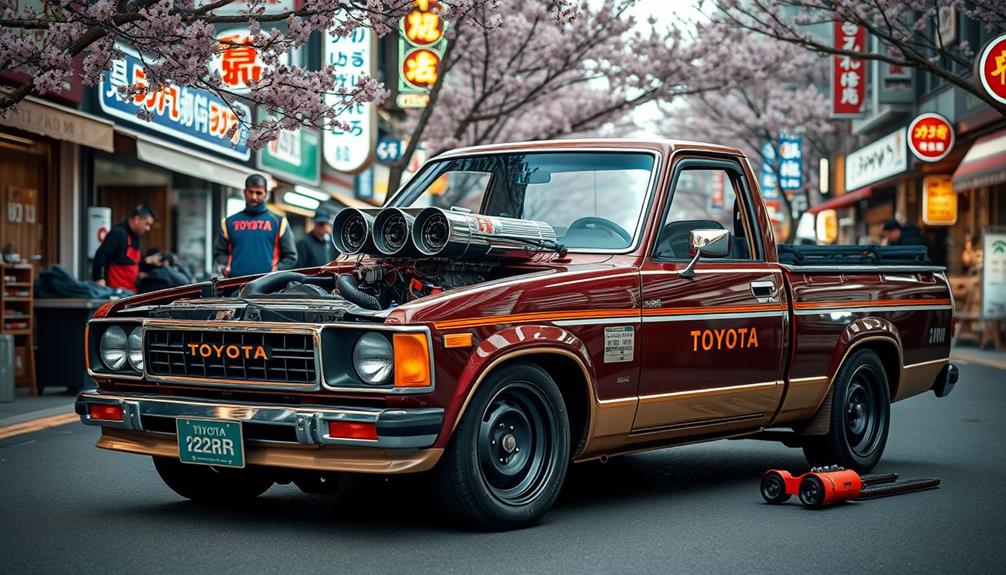
Tuning your JDM Toyota 22R can awaken its performance magic, pushing power from the stock 92hp to over 120hp with the right upgrades. Consider swapping in a Weber carburetor, installing high compression pistons, or even adding a turbo for more excitement. Each modification enhances your engine's response and efficiency, making it a joy to drive. Don't forget about regular tuning to keep everything running smoothly. Whether you're after better acceleration or improved torque, there's a world of tuning possibilities awaiting your classic ride. Keep exploring to discover more upgrades that can elevate your 22R's performance.
Key Takeaways
- The Toyota 22R engine offers reliable performance, with potential modifications increasing power output from 92hp to approximately 120hp or more.
- Upgrading to high-performance carburetors and camshafts can significantly enhance the engine's power and torque, achieving up to 285hp.
- Regular tuning and maintenance are essential for optimizing performance, particularly with side-draft carburetors to prevent common issues like cold start hesitation.
- Turbocharging the 22R engine can yield substantial power gains, reaching up to 120hp at the crank with the right setup and tuning.
- Engaging with online forums and communities provides valuable resources, tips, and support for 22R enthusiasts looking to enhance their vehicles.
Overview of the 22R Engine
The Toyota 22R engine, a stalwart in the lineup of reliable powerplants, is a 2.4L inline-four engine that has gained a loyal following among enthusiasts. With an initial power output of 92hp at the rear wheels, it's a dependable choice for those who appreciate both durability and simplicity.
This engine is commonly found in Toyota trucks and SUVs from the 1980s and early 1990s, particularly the Hilux and 4Runner models.
While the stock performance is solid, you can access even more power through various modifications. The theoretical maximum power is estimated at 120hp at the crank, and you can achieve this with enhancements like high compression pistons and performance cams.
Many enthusiasts opt for aftermarket components, such as Weber carburetors and performance headers, to improve airflow and overall performance.
However, it's essential to recognize that the 22R is often viewed as a reliable engine base that may require substantial modifications to reach higher performance levels.
If you're considering a turbocharged option, the 22RTE variant is worth exploring for a more aggressive power boost.
Key Performance Modifications

For those looking to squeeze more performance out of the 22R engine, several key modifications can make a significant difference. Upgrading to a single d/draft 38 Weber carburetor can dramatically enhance airflow and fuel delivery, bumping your power from 92hp to about 115hp after a rebuild.
Pairing this with high compression pistons and a performance cam, like the Comp Cam 252S, can push your peak horsepower to 124 at 4900 RPM, improving torque in the RPM ranges you commonly drive.
Incorporating extractors and a free-flowing exhaust system will reduce back pressure, further enhancing engine efficiency and acceleration. If you want to improve traction and stability during acceleration, consider switching to a limited-slip differential (LSD).
When combined with performance modifications such as Koni shocks and larger 16-inch rims, you'll notice a substantial improvement in handling.
Don't forget that regular tuning and maintenance of your modified systems, particularly with side-draft Webers, are essential. They may require adjustments to guarantee peak performance and fuel injection efficiency, keeping your 22R engine running at its best.
Performance Limitations and Challenges
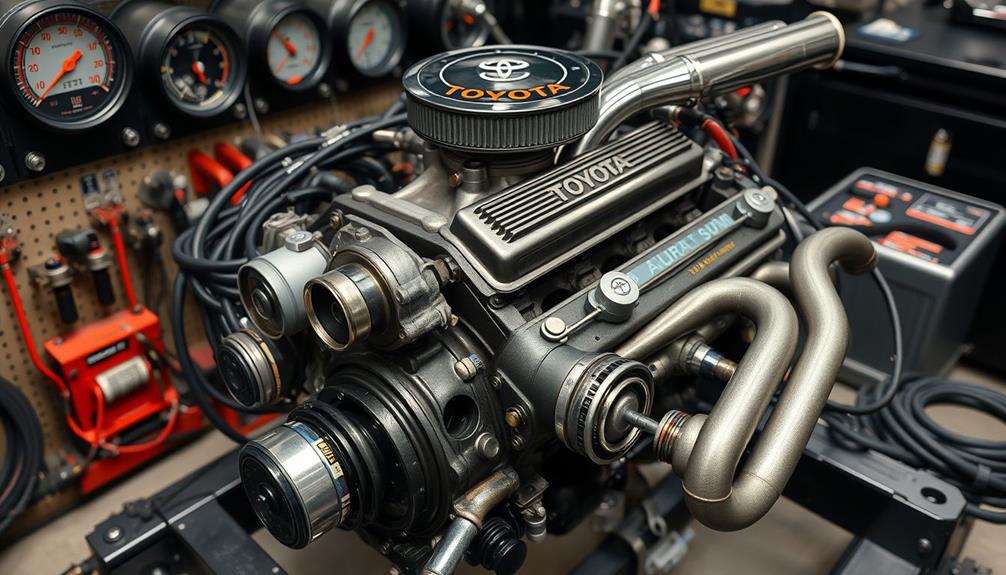
Performance limitations of the Toyota 22R engine can be frustrating for enthusiasts seeking more power. With a theoretical maximum output of around 120hp at the crank, many drivers feel a significant gap between stock performance and their desired output.
You might notice hesitation during cold starts at low revs, a common issue that can hinder your driving experience. Additionally, engine pinging at 4500 rpm on hot days, particularly while climbing hills, poses challenges for maintaining ideal performance.
Many enthusiasts desire at least a 10% power increase at higher revs, highlighting the limitations of the stock setup. It's essential to address these performance limitations through careful tuning and modifications. Without these adjustments, you may experience performance degradation, leading to engine choking before acceleration.
This can create a frustrating scenario where you can't fully enjoy your driving experience. Navigating these challenges requires a solid understanding of the engine's capabilities and limitations.
Camshaft and Carburetor Options

When it comes to tuning the Toyota 22R engine, selecting the right camshaft and carburetor can make a considerable difference in your overall performance. Upgrading your camshaft can enhance torque in commonly driven RPM ranges, making it a crucial choice for performance tuning.
Aftermarket options like the Comp Cam 252S and Erson 268 cam are worth evaluating, as they improve average power and maintain a peak horsepower similar to the stock camshaft.
For carburetor options, think about upgrading to twin side-draft 40mm Webers. These can greatly enhance performance, though they might require regular tuning to achieve ideal results.
Here are some key points to reflect on:
- Torque Improvement: Effective cam choices boost torque where you need it most.
- Carburetor Performance: Side-draft carburetors can outperform the standard single 36mm Weber, but efficiency may vary.
- Expert Tuning: Experienced tuners are essential for proper carburetor adjustment to avoid performance issues.
Investing in the right camshaft and carburetor options will certainly bring your 22R to life, enhancing both power and drivability.
Turbocharging the 22R Engine

Turbocharging the Toyota 22R engine reveals a world of power potential that can transform your driving experience. With custom setups, you could achieve up to 120hp at the crank, depending on your compression ratio and tuning choices.
If you're looking for an exhilarating performance boost, you'll find factory turbocharged models like the 22RTE offer superior capabilities compared to naturally aspirated versions.
When you decide to plunge into turbocharging, proper tuning becomes critical. It maximizes your engine's performance while ensuring reliability and efficiency.
Keep in mind that turbocharging may lead to increased fuel consumption, so balancing power gains with fuel efficiency is essential during the tuning process.
You'll also want to pay attention to supporting components. Installing intercoolers and optimizing your exhaust system are crucial steps for ensuring that your turbocharged 22R setup performs at its best.
Community Resources and Support
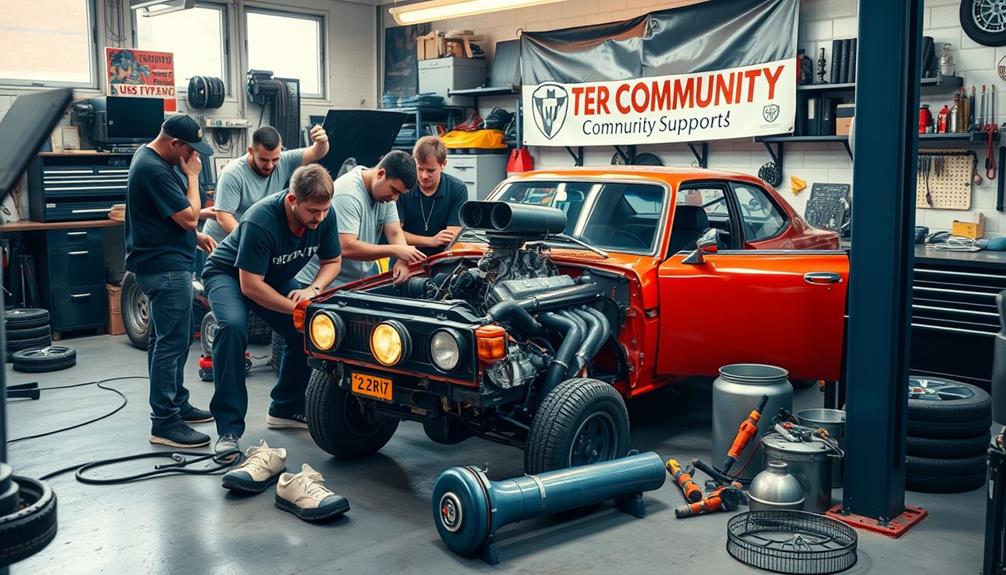
Engaging with online forums can be a game-changer for your 22R tuning journey.
You'll find a treasure trove of shared experiences and tuning tips that can help you make informed decisions about modifications.
Don't forget to share useful threads and connect with fellow enthusiasts who face similar challenges!
Online Forum Engagement
Diving into online forums dedicated to the JDM Toyota 22R can open up a wealth of knowledge and support for enthusiasts. Active participation in these communities lets you exchange valuable information about internal combustion engine modifications, tuning techniques, and best practices for upgrades.
Here are three key benefits of engaging with fellow 22R fans:
- Shared Experiences: Community members often share personal experiences with various performance enhancements, like carburetor options and camshaft upgrades. This fosters a collaborative learning environment where you can learn from others' successes and challenges.
- Troubleshooting Help: Many forums have threads focused on common issues, such as cold start hesitation and engine pings. You can find practical solutions based on collective knowledge, which can save you time and frustration while working on your engine.
- Resource Bookmarking: Users can bookmark and share helpful threads, making it easier to access valuable resources and recommendations from experienced tuners.
Keep in mind the time zone considerations (GMT +10) to guarantee you're engaging with the community when discussions are active, maximizing your chances of getting timely responses.
Tuning Resource Sharing
Tuning resource sharing among JDM Toyota 22R enthusiasts can greatly enhance your engine's performance and reliability. Active online communities and forums are treasure troves of valuable information where you can connect with fellow enthusiasts.
These platforms encourage sharing personal experiences and successful modifications, giving you insights into what works best for your engine.
Specialized performance parts from companies like LC Engineering, including the impressive Stage 5 Pro Stroker motor, can help you achieve up to 285 hp without nitrous.
When considering upgrades like twin side-draft 40mm Webers, it's essential to consult with an experienced tuner for ideal carburetor adjustments.
Regular participation in tech and conversion forums is highly beneficial for exchanging tips on engine modifications and troubleshooting common issues, such as hesitation during cold starts.
Don't overlook local auto recyclers and swap meets; they can be fantastic resources for sourcing hard-to-find parts.
Import Benefits of JDM Vehicles

Many enthusiasts find that importing JDM vehicles offers a unique blend of advantages. Whether you're eyeing a classic model for its heavy-duty performance or simply want something different, the benefits are compelling.
- Regulatory Exemptions: In the U.S., JDM vehicles over 25 years old are exempt from strict safety and emissions standards. This means you can bring in classic models without the hassle of regulatory hurdles.
- Cost Savings: Countries like Australia and various European nations offer tax reductions for older vehicles. For instance, Australian import taxes are lower for cars made before 1989, while European countries provide a 12% tax reduction for vehicles at least 30 years old.
- Engaging Driving Experience: Classic JDM cars typically boast simpler mechanical systems and unique designs. This not only makes maintenance easier but also provides a more engaging driving experience compared to modern vehicles.
Popular JDM Models to Consider
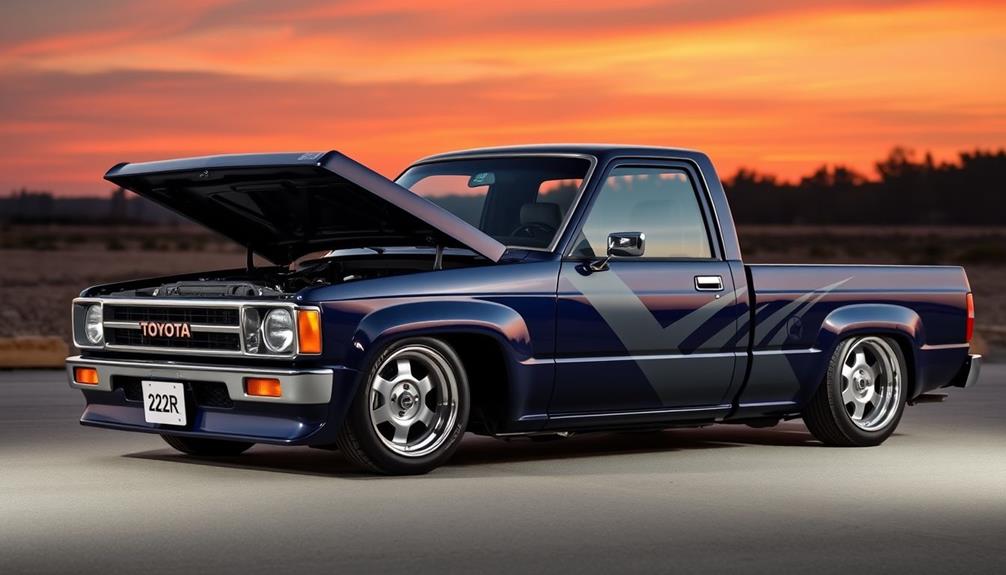
If you're looking for iconic JDM performance legends, there are plenty of options to contemplate.
Models like the Nissan Skyline R32 GT-R and Toyota Chaser offer impressive tuning potential and classic design appeal.
Plus, you might find exciting engine swap opportunities that enhance both performance and driving enjoyment.
Iconic JDM Performance Legends
When diving into the world of JDM performance legends, a few iconic models immediately capture attention, each representing a unique blend of engineering and driving excitement.
These cars not only increase the power but also deliver unforgettable driving experiences.
1. Nissan Skyline R32 GT-R: Known as "Godzilla," this beast boasts a 2.6-liter RB26DETT twin-turbo engine capable of producing up to 600 hp.
Its legendary status in the JDM community is well-deserved.
2. Toyota Chaser/Mark II: With the 1G-GTE engine, these models are celebrated for their perfect balance of power and refinement.
Since 1988, they've become favorite choices among drift and street racing enthusiasts, making them a must-consider option.
3. Nissan Silvia (CA18DET): Renowned for its lightweight design and turbocharged engine, the Silvia offers a responsive platform for modifications.
Its strong following in the tuning scene highlights its appeal to performance enthusiasts.
These iconic JDM models not only stand the test of time but also provide a thrilling foundation for anyone looking to boost their driving experience.
Engine Swap Opportunities
For those looking to elevate their JDM experience, engine swaps offer an exciting way to enhance performance and power. As the demand for skilled trades and hands-on work continues to grow, engine swapping provides a perfect opportunity for enthusiasts to engage in complex problem-solving and technical skills AI Training Jobs Entry Level.
One popular engine swap opportunity is the Toyota Hilux 3RZFE engine. With a theoretical maximum power output of 150 hp at the crank, it provides a noticeable boost over the standard 22R. If you're after even more performance, consider the factory 22RTE turbocharged engine, which delivers superior specs and efficiency.
For enthusiasts wanting to keep that classic JDM vibe, the 1G-GTE from the Toyota Chaser or Mark II is a great option. Known for its solid tuning capabilities, it can produce around mid-200 hp. Alternatively, the Nissan SR20DET engine has gained popularity in older Toyota platforms due to its high power potential and availability.
Lastly, the legendary 2JZ-GE engine can seamlessly fit into classic Toyota chassis, offering incredible reliability and the potential for high horsepower. Each of these engine swap opportunities not only enhances performance but also allows you to connect more deeply with JDM culture while enjoying your classic build.
Classic Design Appeal
Embracing the classic design appeal of popular JDM models can truly elevate your automotive experience.
These vehicles not only showcase stunning aesthetics but also offer impressive performance and tuning potential. If you're considering a classic, here are three iconic options to explore:
- Nissan Skyline R32 GT-R – Known as "Godzilla," this beast features a powerful 2.6-liter RB26DETT twin-turbo inline-six engine, pushing out up to 600 hp. Its racing pedigree combined with aggressive styling makes it a must-have.
- Toyota Chaser and Mark II – Since 1988, these models have captured the hearts of JDM enthusiasts. Equipped with the 1G-GTE engine, they deliver exceptional performance and endless tuning possibilities, all wrapped in a classy design.
- Nissan Silvia (CA18DET) – Renowned for its lightweight build and turbocharged engine, the Silvia is a favorite among drift enthusiasts. Its sleek lines and agile handling enhance its classic design appeal.
Each of these models holds a special place in automotive history, making them excellent choices for anyone looking to embrace the timeless allure of JDM classics.
Future of JDM Performance Tuning
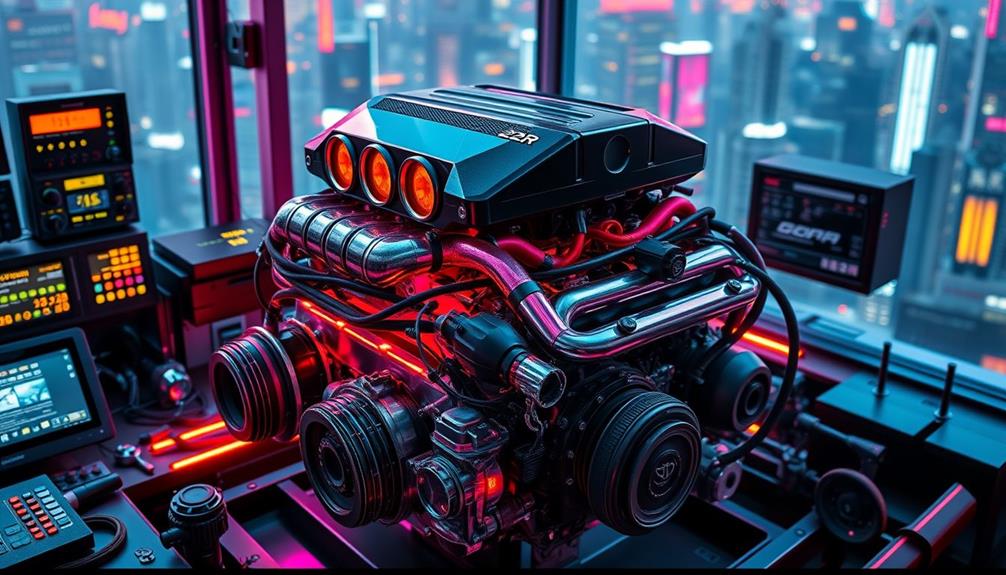
As the landscape of JDM performance tuning evolves, enthusiasts are discovering new ways to reveal the potential of classic engines like the Toyota 22R.
With simulations indicating a theoretical maximum power of around 120hp at the crank, there's plenty of room for performance enhancements through careful tuning and modifications. One key area to focus on is performance cam options. Selecting the right cam, such as the Comp Cam 252S or Erson 268, can push your 22R to peak horsepower of about 124hp.
Moreover, upgrading to a turbocharged setup can greatly boost power, but you'll need to fine-tune it to maintain reliability and manage fuel consumption effectively.
Community insights highlight that modifications like high-flow headers and performance carburetors can greatly enhance the 22R's performance while keeping fuel efficiency in check.
Engaging with online forums and local automotive groups can provide you with invaluable resources and shared experiences.
By tapping into this knowledge, you can navigate the evolving world of JDM performance tuning and achieve your desired performance outcomes for the Toyota 22R.
The future of tuning is bright, and it's up to you to seize the opportunities it presents.
Frequently Asked Questions
How Can I Make My 22R More Powerful?
To make your 22R more powerful, consider upgrading to a performance cam, installing a Weber carburetor, adding headers, or even turbocharging it. Regular maintenance and tuning will also keep your engine running efficiently and powerfully.
How Much Horsepower Does a Stock 22R Have?
Oh, you thought your stock 22R was a powerhouse? It's only got about 92 horsepower at the rear wheels. But hey, it's reliable! Just don't expect to win any races with that.
How Long Does Toyota 22R Engine Last?
Your Toyota 22R engine can last over 200,000 miles with proper maintenance. Regular oil changes and tune-ups are key, and many enthusiasts even report exceeding 300,000 miles with mild modifications and consistent care.
What Was the Last Year Toyota Used the 22R Engine?
The last year Toyota used the 22R engine was 1995. You'll find this engine in models like the Pickup and 4Runner, known for their reliability and ease of maintenance throughout its production run.
Conclusion
In the world of performance tuning, the Toyota 22R engine is a hidden gem waiting to shine. By embracing the right modifications and tapping into the vibrant JDM community, you can transform your classic ride into a roaring beast that commands attention on the road. As you rev up your engine and feel the thrill of each modification, remember—this journey isn't just about speed; it's about crafting a unique story that celebrates the spirit of Japanese engineering.
Jimmy is a dedicated drift and drag racing enthusiast who deeply understands the unique tuning requirements for these high-octane sports. His expertise covers everything from drift suspension setups to drag racing launch control systems, providing our readers with the knowledge they need to compete at the highest levels. Jimmy’s passion for these motorsports shines through in his detailed articles and practical recommendations.
Toyota Tuning
Toyota Land Cruiser Tuning: Maximizing Power and Off-Road Capability in Your SUV
Optimize your Toyota Land Cruiser’s performance and off-road prowess with expert tuning techniques that could unlock untapped potential. Discover how to elevate your adventure!

Tuning your Toyota Land Cruiser can greatly boost its power and off-road capability. Start with ECU remapping for up to a 40% increase in horsepower and torque. Pair this with high-flow exhaust systems and performance air intakes to enhance airflow and throttle response. Upgrading fuel injectors and incorporating larger turbochargers can elevate performance further, especially in demanding situations. Advanced cooling solutions help maintain engine efficiency under tough conditions. With the right combination of upgrades tailored to your driving style, you can transform your Land Cruiser into a powerhouse ready for any adventure. Explore more ways to maximize your SUV's potential!
Key Takeaways
- ECU remapping can boost horsepower and torque by up to 40%, enhancing overall engine performance for off-road adventures.
- Upgrading to high-flow exhaust systems improves airflow and throttle response, vital for tackling tough terrains.
- Installing larger, more efficient turbochargers significantly increases engine power and responsiveness, essential for off-road capability.
- High-performance fuel injectors optimize combustion, ensuring better power delivery and preventing fuel starvation during demanding conditions.
- Enhanced cooling solutions maintain engine performance under stress, preventing overheating and ensuring reliability during off-road excursions.
Overview of Tuning Options
Exploring tuning options for your Toyota Land Cruiser can greatly enhance its performance and adaptability. By focusing on the engine control unit (ECU), you can access the full potential of your vehicle's engine. This not only boosts power and torque but also adapts your SUV for towing and off-road adventures.
Performance upgrades come in various forms, including airboxes, exhaust systems, and injector enhancements. These upgrades are tailored to meet your specific driving needs, optimizing overall performance.
For the J150 engine, advanced tuning options improve throttle response and fuel efficiency while eliminating factory restrictions.
One of the standout features is the multi-mapping capability, allowing you to switch between different engine tunes. Whether you're towing heavy loads, steering through city streets, or tackling rugged terrains, you can easily cater the performance to fit your driving scenario.
Upgrading to high-flow exhaust systems and aftermarket airboxes greatly improves airflow, resulting in increased horsepower and an enhanced driving experience.
With these tuning options, you'll not only elevate your Land Cruiser's performance but also enjoy a more versatile and capable ride.
ECU Remapping Benefits

Upgrading your Toyota Land Cruiser's ECU through remapping offers significant benefits that can transform your driving experience.
With ECU remapping, you can achieve up to a 40% increase in torque and horsepower, which greatly enhances the vehicle's overall performance. By removing factory restrictions, you'll optimize throttle response, leading to quicker acceleration and improved drivability. This means your Land Cruiser will respond precisely to your commands, whether you're tackling tough terrain or cruising on the highway.
Additionally, understanding your investment goals can help you make informed decisions about modifications that enhance your vehicle's value.
Moreover, ECU remapping allows for tailored engine performance, catering to your specific driving needs, be it towing heavy loads, off-roading adventures, or daily commutes. You won't have to compromise on power either, as enhanced fuel economy can be achieved through this tuning. This makes it a cost-effective upgrade that not only boosts performance but also helps save on fuel costs.
Before diving into the remapping process, a thorough assessment of your engine's state guarantees that you maximize the potential of your vehicle's existing hardware.
In short, ECU remapping is a smart choice for anyone looking to elevate their Toyota Land Cruiser's capabilities on and off the road.
Performance Exhaust Upgrades

A performance exhaust upgrade can greatly enhance your Toyota Land Cruiser's capabilities, transforming not just power but also the driving experience. By opting for larger diameter piping and high-flow mufflers, you'll reduce backpressure, improving overall airflow and boosting horsepower. A stainless steel or titanium exhaust system enhances the iconic V8 exhaust note, making every drive more exhilarating.
When you invest in these performance exhaust upgrades, you'll likely notice immediate improvements in throttle response and acceleration. This makes every off-road adventure more engaging and enjoyable. Additionally, pairing the installation of a high-performance exhaust system with ECU remapping is essential for revealing the full potential of your modifications.
Here's a quick overview of the benefits:
| Upgrade Type | Key Benefit | Recommended Action |
|---|---|---|
| Larger Diameter Piping | Reduces backpressure | Install a high-flow system |
| High-Flow Mufflers | Enhances horsepower | Choose stainless or titanium |
| ECU Remapping | Optimizes engine performance | Tune after exhaust install |
| Improved Throttle | Increases responsiveness | Test drive before/after |
Turbocharger Enhancements

If you're looking to boost your Toyota Land Cruiser's performance, upgrading the stock turbochargers is a smart move.
You'll enjoy significant gains in horsepower and torque, making your ride more responsive, especially when towing or off-roading.
Just remember, proper installation and tuning are key to releasing these benefits while keeping your engine healthy.
Stock Turbo Limitations
The stock turbochargers on the Toyota Land Cruiser often hinder the engine's true potential, thanks to their conservative boost levels. This limitation restricts overall power output, leaving you craving more performance during off-road adventures. While some models feature larger factory-installed turbos, they still may not meet your needs for maximum efficiency.
| Stock Turbo Limitations | Impact on Performance | Aftermarket Upgrades |
|---|---|---|
| Conservative boost levels | Reduced horsepower and torque | Larger, more efficient turbos |
| Limited airflow | Slower spool times | Enhanced airflow systems |
| Inefficient throttle response | Poor acceleration | Improved tuning options |
Upgrading to larger or more efficient turbochargers can greatly enhance both horsepower and torque, giving your Land Cruiser the performance boost you desire. Enhanced turbo options allow for increased airflow and quicker spool times, ultimately improving throttle response. However, to fully realize the benefits of these aftermarket upgrades, proper tuning and supporting modifications—such as improved intercoolers and exhaust systems—are essential. By addressing these stock turbo limitations, you'll reveal your SUV's full potential for thrilling off-road adventures.
Turbo Upgrade Benefits
Upgrading your Toyota Land Cruiser's turbochargers can unleash a whole new level of performance and efficiency. By enhancing your vehicle's turbo system, you can experience significant improvements in power output and responsiveness, transforming your driving experience both on and off the road.
- Increased horsepower and torque
- Quicker throttle response
- Improved fuel efficiency
- Enhanced overall performance
Turbo upgrades are essential for maximizing your engine's potential. Stock turbos may limit performance, but larger aftermarket options can provide substantial gains. When paired with other modifications like ECU remapping and exhaust enhancements, these upgrades can reveal even more power.
With improved turbochargers, you'll notice a more dynamic driving experience. A well-matched turbo can lead to quicker throttle response, allowing you to accelerate faster and navigate challenging terrains with ease.
Plus, you won't have to sacrifice fuel efficiency; a good turbo upgrade can help maintain power without excessive fuel consumption.
Incorporating these enhancements will help you enjoy the full capabilities of your Toyota Land Cruiser, making every adventure more exhilarating. Embrace the benefits of turbo upgrades and elevate your SUV's performance to new heights!
Installation and Tuning Considerations
When you're considering turbocharger enhancements for your Toyota Land Cruiser, installation and tuning play essential roles in releasing the engine's full potential. Upgrading to high-performance turbos can greatly boost power output and efficiency, but it's important to confirm proper installation and tuning to maximize performance improvements.
| Consideration | Importance | Recommended Action |
|---|---|---|
| Turbo Upgrades | Increases boost and throttle response | Choose high-quality aftermarket options |
| Installation Process | Affects performance and reliability | Follow manufacturer guidelines for installation |
| Tuning | Guarantees optimal fuel delivery | Utilize professional tuning services |
| Dyno Testing | Validates performance gains | Schedule post-installation testing |
| Maintenance | Keeps the system running efficiently | Regular checks on turbo and engine components |
Proper tuning after turbo upgrades is critical to achieve the perfect air-fuel mixture, ensuring reliability while enhancing performance. Don't skip dyno testing; it helps verify that your enhancements are delivering the intended results and allows for adjustments to your tuning parameters. With these considerations in mind, you'll release your Land Cruiser's true power and off-road prowess.
Fuel Injector Upgrades

When you're tuning your Toyota Land Cruiser, upgrading your fuel injectors is essential for boosting engine performance.
High-performance injectors improve the fuel-to-air mixture, which can greatly enhance horsepower and torque, especially during off-road adventures.
This upgrade not only supports your engine's power demands but also guarantees smoother acceleration and a more responsive driving experience.
Importance of Fuel Injectors
Fuel injectors play a vital role in maximizing the performance of your tuned Toyota Land Cruiser. Upgrading these components is essential for enhancing power production and engine efficiency.
Here's why you should consider fuel injector upgrades:
- Better atomization: High-performance fuel injectors improve the fuel-to-air mixture, leading to more efficient combustion.
- Increased flow rates: With greater flow capabilities, your engine can achieve higher horsepower and torque outputs post-tuning.
- Prevent fuel starvation: Upgraded injectors guarantee your vehicle doesn't run into issues, especially when you push the limits during off-road adventures.
- Enhanced throttle response: Properly sized and calibrated injectors can greatly improve your vehicle's acceleration and responsiveness.
To guarantee you're selecting the right injectors, conduct pre-tuning inspections and dyno assessments. This step will help you determine the appropriate specifications, making certain your upgrades align with your existing modifications and overall engine performance.
By investing in high-quality fuel injectors, you're not just boosting power production but also enriching the entire driving experience, especially when tackling challenging terrains.
Don't overlook this vital upgrade if you want your Toyota Land Cruiser to perform at its best!
Performance Gains Achieved
Upgrading your Toyota Land Cruiser's fuel injectors can lead to impressive performance gains that elevate your driving experience. By installing high-performance fuel injectors, you enhance the fuel-to-air mixture, resulting in better combustion and increased horsepower.
This boost in power is vital, especially during towing or maneuvering off-road conditions where engine efficiency matters most.
Additionally, injector upgrades can considerably increase torque, making it easier for you to tackle steep inclines and challenging terrains. With the right injectors, your vehicle's ability to handle demanding situations improves, giving you the confidence to explore further off the beaten path.
Before diving into the upgrade, it's important to perform a pre-tuning inspection and dyno assessment. This step guarantees peak compatibility and maximizes the performance improvements you can achieve.
Upgrading to high-flow injectors ensures your engine receives sufficient fuel under increased performance conditions, enhancing throttle response and acceleration.
Emission System Solutions
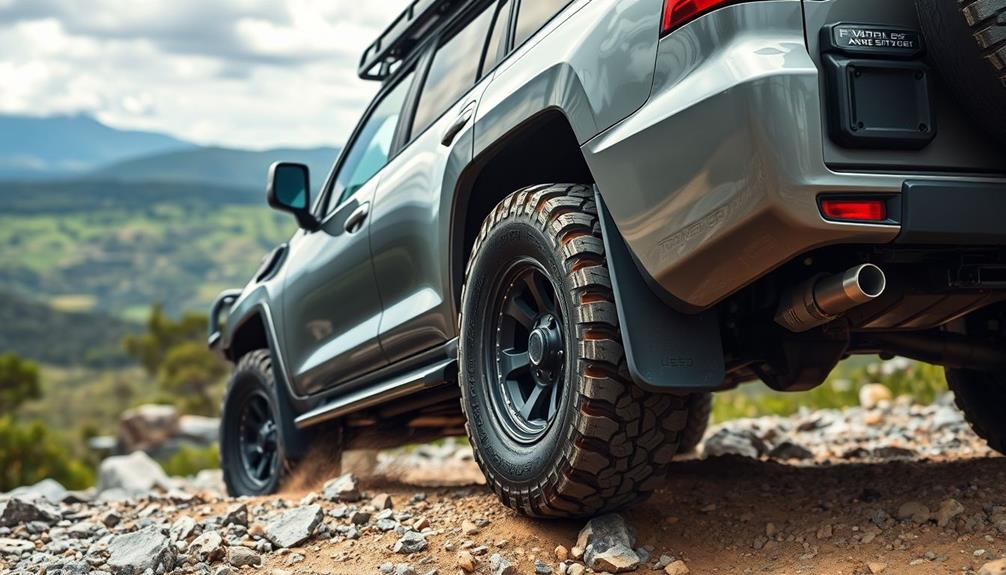
If you're looking to enhance your Toyota Land Cruiser's performance while managing emissions, exploring emission system solutions is key. Customizing your emission systems can lead to improved power and efficiency without compromising compliance with regulations.
Here are some effective strategies:
- Disable Exhaust Gas Recirculation (EGR) for better performance
- Optimize Diesel Particulate Filters (DPF) for enhanced vehicle performance
- Implement custom tuning for Selective Catalytic Reduction (SCR) systems
- Address Diesel Treatment Codes (DTC) for operational integrity
Focusing on these solutions allows you to tackle challenges posed by DPFs while ensuring your vehicle meets legal standards.
Disabling EGR can enhance throttle response and overall power, making your Land Cruiser more responsive.
Tailored approaches to DPF management can help maintain compliance without sacrificing performance.
Additionally, custom tuning of SCR systems can improve engine efficiency, reducing harmful emissions.
Performance Metrics and Results

Enhancing your Toyota Land Cruiser's emission systems not only boosts performance but also opens the door to impressive metrics that demonstrate the vehicle's capabilities.
With effective ECU remapping, you can achieve significant power and torque results, with gains of up to 40%. These enhancements are reflected in performance metrics that show how your SUV can tackle both on-road and off-road challenges confidently.
Post-tuning performance tests reveal an improved throttle response, allowing for quicker acceleration and better driving dynamics. You'll notice a marked difference during overtaking maneuvers, making them safer and more efficient.
Additionally, upgrading your exhaust system and air intake can greatly improve airflow, further elevating overall engine performance.
Continuous monitoring of performance metrics guarantees that your tuning remains ideal, adapting to various driving scenarios while maintaining engine efficiency.
This not only enhances your Land Cruiser's capabilities but also assures that you have the power when you need it most, whether you're cruising on the highway or steering through challenging terrains.
With these tuning improvements, your Toyota Land Cruiser is ready to perform at its best, no matter the environment.
Case Studies of Successful Tuning

When considering the impact of tuning on your Toyota Land Cruiser, case studies reveal compelling evidence of its effectiveness. For instance, the successful tuning of the 2016 Land Cruiser using Alientech KESS3 led to a remarkable boost in power and torque, greatly enhancing its towing capabilities and overall driving experience.
Here are some standout examples of tuning success:
- The 2019 Kia Sorento showcased improved performance and reliability through customized tuning solutions.
- Tuning the 2012 Skoda Octavia transformed its driving dynamics, highlighting how targeted modifications elevate performance metrics.
- The 2015 Jeep Grand Cherokee optimized its off-road capabilities, proving the importance of tailored tuning for enhancing specific functionalities.
- The 2020 Toyota GR Yaris tuning maximized rally-inspired performance, demonstrating the diverse benefits of tuning across various Toyota models.
These case studies illustrate that tuning can dramatically improve your SUV's performance and capabilities.
By applying targeted modifications, you can access your Land Cruiser's full potential, making it not just a vehicle, but a powerhouse on and off the road.
With the right tuning, your adventures can become even more thrilling and efficient.
Additional Performance Modifications
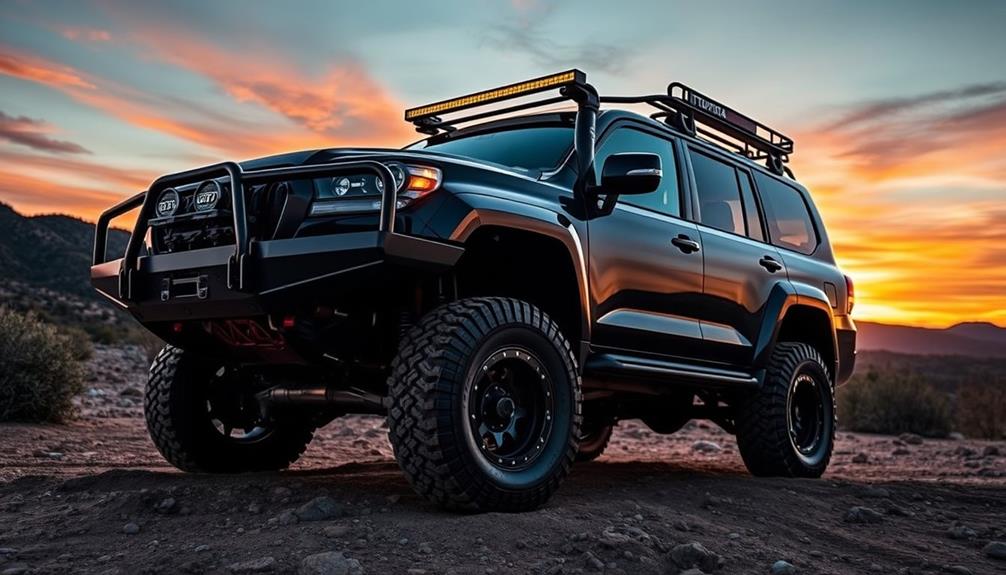
When you're looking to boost your Toyota Land Cruiser's performance, upgrading fuel injectors is a smart starting point.
Enhanced turbocharger performance and advanced cooling solutions can further elevate your engine's capabilities, ensuring it runs smoothly under pressure.
Together, these modifications can transform your ride into a powerhouse on and off the road.
Upgraded Fuel Injectors
Upgrading fuel injectors is an important step for boosting the performance of your Toyota Land Cruiser, especially if you're working with a diesel model like the 1KD-FTV engine. High-performance injectors enhance combustion efficiency, leading to increased power output and better overall engine performance.
When you upgrade, you're not just changing parts; you're optimizing your entire fuel system.
Consider these benefits of upgraded fuel injectors:
- Enhanced fuel atomization for improved combustion
- Increased power output without sacrificing drivability
- Compatibility with ECU remapping for tailored performance
- Reduced emissions with a better fuel-to-air mixture
Choosing the right size and type of injectors is vital, aligning with your performance goals and existing modifications. This prevents issues like excessive smoke or poor drivability.
It's also wise to have a professional handle the installation, and a pre-tuning inspection guarantees everything's compatible.
Enhanced Turbocharger Performance
Boosting your Land Cruiser's performance often means diving into enhanced turbocharger options, which can transform your driving experience. Upgrading the turbocharger markedly increases engine efficiency and power output, allowing you to conquer steep inclines and challenging terrains with ease. The stock turbo may hold back your engine's potential, but aftermarket upgrades can deliver a substantial boost in horsepower and torque, often exceeding factory specifications.
Here's a quick overview of the benefits of enhancing turbocharger performance:
| Turbocharger Upgrade | Performance Gains | Off-Road Benefits |
|---|---|---|
| Stock Turbo | Limited power | Restricted torque |
| Aftermarket Turbo | Substantial increase | Improved traction |
| Larger Factory Turbo | Enhanced throttle response | Better efficiency |
| High-Flow Options | Optimized performance | Consistent power delivery |
Advanced Cooling Solutions
Advanced cooling solutions are essential for maximizing your Toyota Land Cruiser's performance, especially during demanding off-road adventures. By investing in these modifications, you can guarantee your engine maintains its power and reliability even in extreme conditions.
- Top-mounted intercoolers boost cooling efficiency, enhancing power output.
- Enhanced cooling systems prevent heat soak, maintaining peak performance.
- High-performance intercoolers improve horsepower and torque for tackling tough terrains.
- Larger intercoolers further enhance cooling, guaranteeing consistent power delivery.
When you upgrade your Land Cruiser with advanced cooling solutions, you effectively prevent power loss due to overheating. This means your vehicle can handle steep inclines and challenging landscapes without breaking a sweat.
With improved cooling capabilities, you'll experience better engine reliability during prolonged use, allowing you to push your SUV to its limits.
Incorporating these performance upgrades not only elevates your vehicle's capability but also provides peace of mind on the trail. So, if you're ready to conquer the toughest off-road challenges, focus on enhancing your cooling systems for peak performance and engine reliability.
Expert Recommendations for Upgrades
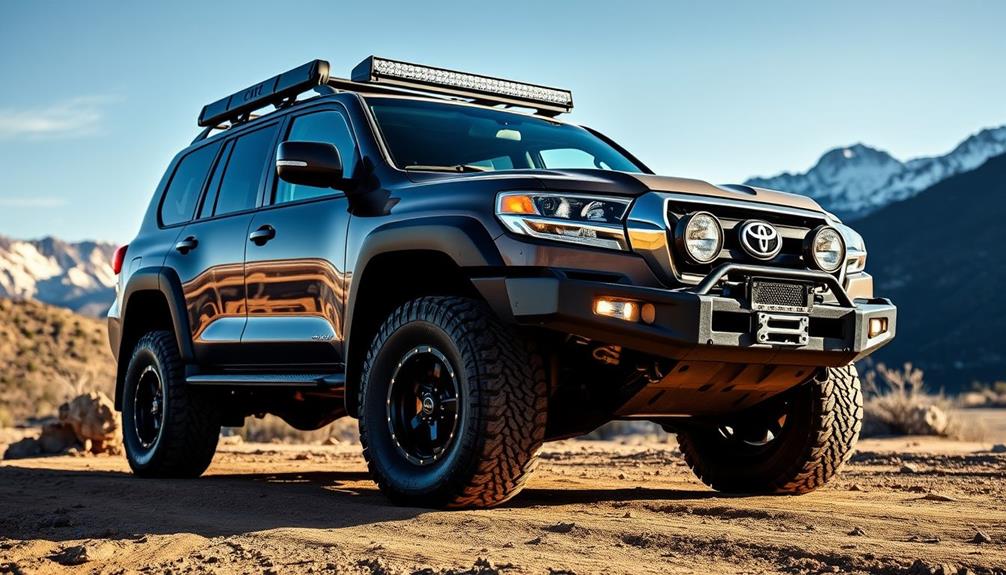
Maximizing your Toyota Land Cruiser's performance involves making strategic upgrades that cater to your driving style and needs.
One of the most effective modifications is ECU tuning. Remapping your ECU can lead to power and torque increases of up to 40%, greatly enhancing your driving experience, especially for towing and off-road adventures.
Next, consider installing a high-flow aftermarket exhaust system. This upgrade improves exhaust flow and reduces backpressure, resulting in enhanced horsepower.
Plus, it gives your SUV a more aggressive sound profile that matches its rugged aesthetic. Make sure to incorporate larger diameter piping and high-efficiency catalytic converters to maintain compliance with emissions regulations while optimizing performance.
Don't overlook the importance of performance-oriented air intake systems. These systems facilitate better airflow to the engine, optimizing combustion efficiency and offering noticeable gains in both power and fuel efficiency.
Frequently Asked Questions
Can You Tune a Land Cruiser?
Yes, you can tune a Land Cruiser to enhance its performance. By utilizing ECU remapping and upgrading components like exhaust systems and air intakes, you'll considerably boost power and improve overall driving dynamics for various conditions.
Can You Increase the Towing Capacity of a Land Cruiser?
Sure, you can increase your Land Cruiser's towing capacity. By tuning the engine and enhancing components like the exhaust and transmission, you'll boost power and torque, making heavy loads safer and easier to handle.
How Much Horsepower Does a Land Cruiser SUV Have?
You'll find that the Toyota Land Cruiser varies in horsepower depending on the model. The 200 Series has about 200 horsepower, while the 300 Series boasts an impressive 409 horsepower, enhancing overall performance considerably.
How to Get More Power Out of a 79 Series?
To release the beast within your 79 Series, consider upgrading the exhaust, installing a performance air intake, remapping the ECU, and adding larger fuel injectors. A turbocharger can skyrocket your power even further.
Conclusion
In the world of off-roading, tuning your Toyota Land Cruiser is like giving it a new set of wings. Just as a bird soars higher with stronger feathers, your SUV can tackle tougher terrains with the right upgrades. With ECU remapping, performance exhausts, and more, you're not just enhancing power; you're revealing its true potential. So, gear up and transform your ride into the ultimate adventure machine—it's time to take your journeys to new heights!
Jimmy is a dedicated drift and drag racing enthusiast who deeply understands the unique tuning requirements for these high-octane sports. His expertise covers everything from drift suspension setups to drag racing launch control systems, providing our readers with the knowledge they need to compete at the highest levels. Jimmy’s passion for these motorsports shines through in his detailed articles and practical recommendations.
Toyota Tuning
Toyota Camry 2013 Tuning: Enhancing Performance in Your Reliable Sedan
Harness the potential of your 2013 Toyota Camry with tuning options that elevate performance—discover how to transform your reliable sedan into a powerhouse.

Tuning your 2013 Toyota Camry is an exciting way to enhance performance and enjoy a more dynamic driving experience. With tuning options ranging from Stage 1 to Stage 2+, you can boost horsepower considerably, going up to 208 HP. Upgrading your suspension and installing a rear sway bar also improves handling and stability. Choosing the right tires and rims can enhance grip and responsiveness, while regular maintenance guarantees peak performance. Whether you seek an economical drive or thrilling speed, there's a lot to explore in enhancing your Camry's capabilities that you won't want to miss.
Key Takeaways
- Expert tuning services for the Toyota Camry 2013 boost performance with horsepower gains ranging from 177 HP to 208 HP across different stages.
- Custom ECU tuning optimizes engine capabilities, enhancing both performance and fuel efficiency, particularly with high-octane fuel.
- Upgrading suspension components, like sway bars and lowering springs, improves handling and cornering stability for a more engaging driving experience.
- Regular maintenance, including oil changes and air filter replacements, is crucial for sustaining peak performance after tuning modifications.
- Engaging with the automotive community and participating in events can provide valuable insights and best practices for effective performance enhancements.
Tuning Services Offered
When it comes to enhancing your Toyota Camry's performance, expert tuning services tailored for the XV50 (2011-2017) 2.5L 2AR-FE engine are readily available.
These services focus on optimizing your vehicle's throttle response, ensuring a more engaging driving experience. You can choose from three tuning levels: Stage 1 offers a boost to 177 HP for $450, Stage 2 ramps it up to 193 HP for $150, and Stage 2+ maxes out at 208 HP for $190.
Each stage provides significant gains in horsepower and torque, allowing you to pick the one that fits your performance goals.
In addition to standard tuning, you can take advantage of custom tuning services that cater to a variety of vehicle brands, including exotics. This means you'll receive individualized enhancements tailored specifically for your Camry.
Additional options include DTC fault code removal for $100 and EGR delete or speed limiter removal for $85 each. By reprogramming the ECU, these services harness the potential of aftermarket parts, enhancing overall drivability and performance, especially when using 91/93 octane fuel.
Your Camry can truly transform into a more responsive and powerful sedan with the right tuning.
Pricing Structure

Understanding the pricing structure for tuning your 2013 Toyota Camry is essential for making an informed decision.
You'll want to weigh your options carefully to enhance your vehicle's performance without breaking the bank.
Here's a quick overview of the costs involved:
- Stage 1 tune: $450.00 (includes new tool and software)
- Stage 2 tune: $150.00
- Stage 2+ tune: $190.00
- Additional services:
- Speed limiter removal: $85.00
- EGR delete: $85.00
- DTC fault code removal: $100.00
- Premium upgrade package (free updates and custom adjustments): $1,200.00
Performance Enhancements

When you tune your 2013 Toyota Camry, you'll see significant gains in horsepower and torque, especially with options like the Stage 1 and Stage 2 tunes.
These enhancements not only boost performance but can also improve fuel efficiency, making your drive more enjoyable and economical.
With custom ECU tuning and additional modifications, you can truly optimize your Camry's capabilities.
Horsepower and Torque Gains
Tuning the 2013 Toyota Camry can release impressive horsepower and torque gains that greatly enhance your driving experience. By opting for different tuning stages, you can reveal significant performance improvements. Here's what you can expect:
- Stage 1 Tune: Boosts horsepower to 177 HP and torque to 170 lb.ft.
- Stage 2 Tune: Increases horsepower to 193 HP while enhancing torque to 182 lb.ft.
- Stage 2+ Tune: Maximizes your Camry's potential with 208 HP and 196 lb.ft of torque.
- Optimized for 91/93 Octane Fuel: guarantees your engine runs both efficiently and powerfully.
These tuning options not only improve horsepower and torque but also enhance throttle response.
You'll feel the difference in acceleration and overall driving dynamics. With each stage, your Camry transforms from a reliable sedan into a spirited performer on the road.
Whether you're merging onto the highway or steering through city streets, these upgrades provide a more engaging driving experience.
Don't miss the chance to elevate your Camry's performance and enjoy the thrill of every drive!
Fuel Efficiency Improvements
How can you make your 2013 Toyota Camry more fuel-efficient while boosting performance? Start by considering a Stage 1 tuning for your Camry's 2.5L 2AR-FE engine. This upgrade can increase horsepower to 177 HP and torque to 170 lb-ft, enhancing power delivery while reducing fuel consumption during acceleration.
Optimizing the ECU's programming allows for a better fuel-air mixture, improving combustion efficiency and overall fuel efficiency. Additionally, understanding your budget for these enhancements is essential to make informed decisions.
Additionally, enhanced throttle response makes it easier to drive efficiently, cutting down on unnecessary fuel usage in daily driving conditions. You might also want to switch to higher octane fuel (91/93) to further maximize your engine's capabilities.
Another performance enhancement you could consider is lowering springs. These can improve your vehicle's aerodynamics and stability, leading to better handling and potentially more economical driving.
With smoother acceleration and improved drivability from tuning and lowering springs, you'll naturally adopt a more economical driving style, contributing to improved fuel efficiency. By combining these strategies, you can enjoy a Camry that's not only reliable but also more fuel-efficient, keeping your costs down while enhancing your driving experience.
Handling and Suspension Upgrades

When you're looking to boost your Toyota Camry's handling, upgrading suspension components is a great place to start.
Enhancing your sway bars can greatly reduce body roll and improve stability, giving you a more controlled driving experience.
Pair these upgrades with quality tires, and you'll notice a remarkable difference in performance on the road.
Suspension Component Upgrades
Upgrading the suspension on your 2013 Toyota Camry can transform your driving experience, making it more engaging and responsive.
By investing in suspension upgrades, you'll notice a remarkable difference in handling and overall performance. Effective keyword optimization can also enhance your search visibility for related tuning parts.
Here are some key enhancements to take into account:
- Lowering Springs or Coilovers: These options lower your center of gravity, which reduces body roll and improves cornering stability.
- Poly Control Arm and Steering Rack Bushings: These components minimize flex and enhance steering response, making your driving more precise.
- High-Quality Tires: Pairing your suspension upgrades with tires like the Michelin Pilot Super Sport maximizes grip and performance on the road.
- Consistent Rim Width and Offset: Maintaining uniformity across all wheels is essential for ideal handling in your front-wheel-drive Camry.
These upgrades work together to give you a more balanced and controlled ride.
With the right suspension components, you'll experience improved stability and cornering capabilities, making each drive in your Camry not just reliable, but also thrilling.
Sway Bar Enhancements
Enhancing your 2013 Toyota Camry with a sway bar upgrade can make a significant impact on its handling and overall driving experience. By installing a rear sway bar, like the 19mm Progress or 23mm Ultra Racing, you'll particularly reduce body roll during cornering, leading to improved handling characteristics.
This upgrade enhances stability and responsiveness, providing a more engaging drive without sacrificing everyday comfort.
You'll notice a remarkable difference in cornering capabilities, as a well-chosen sway bar setup allows for more precise steering input and boosted driver confidence. If you've already considered other suspension modifications, such as lowering springs or coilovers, sway bar enhancements can complement these upgrades to create a balanced, performance-oriented dynamic.
However, keep in mind that consistency is key. When upgrading, make sure that you maintain the same width and offset across all rims. This will help avoid instability and guarantee peak handling performance.
With the right sway bar enhancements, your Camry won't only handle better but also feel more connected to the road, making your drives more enjoyable.
Tire and Rim Selection

Selecting the right tires and rims for your 2013 Toyota Camry is essential for maximizing performance and comfort. The right combination can greatly enhance your driving experience. Here are four key factors to take into account:
- Rim Size: Opt for 18 x 8.5 rims for ideal handling with minimal sidewall flex.
- Tire Sizes: Use recommended tire sizes of 255 or 265/40 to guarantee proper fitment and maintain speedometer accuracy.
- Weight of Rims: Choose lighter rims to improve inertia while making sure they maintain structural integrity for safety.
- Width and Offset: For front-wheel-drive vehicles like the Camry, keeping consistent width and offset across all rims is fundamental for stability and handling performance.
When selecting tires, weigh the trade-off between comfort and handling. Comfort tires offer a smoother ride, while sport tires enhance grip and responsiveness.
Maintenance and Community Insights

When it comes to maintaining your 2013 Toyota Camry, regular checks are essential for keeping performance at its peak, especially after any modifications. Incorporating data-driven strategies into your maintenance routine can yield measurable results, ensuring that your vehicle's performance remains ideal.
Oil changes and air filter replacements are critical for ensuring your engine runs smoothly. Don't forget to monitor your brake fluid and coolant levels, as these are fundamental for safe driving post-modification.
Engaging with community insights can greatly enhance your maintenance routine. Many enthusiasts participate in events like SCCA, where lowering their vehicles has become a common practice to improve handling. This shared knowledge can help you understand the best practices and performance tweaks tailored to your Camry's needs.
Online forums are another valuable resource. They reveal varying levels of expertise among community members, highlighting the importance of researching your specific modifications before diving in.
By actively participating in these discussions, you can gain insights into effective maintenance strategies and common pitfalls to avoid.
Ultimately, staying informed through community insights and adhering to a consistent maintenance schedule will keep your 2013 Camry performing at its best, ensuring your driving experience remains enjoyable and reliable.
Frequently Asked Questions
Can Toyota Camry Be Tuned?
Yes, you can tune a Toyota Camry. By opting for performance tunes, you'll boost horsepower and torque. Customized tuning services are available, ensuring your car runs efficiently while enhancing its overall driving experience.
How Much Does a Tune up Cost for a 2013 Toyota Camry?
Tuning's like a double-edged sword—boosting performance while costing money. For your 2013 Camry, expect to spend around $450 for a Stage 1 tune, with additional options available to enhance your driving experience even further.
How Many Miles Will a 2013 Toyota Camry Last?
Your 2013 Toyota Camry can last between 200,000 to 300,000 miles with proper maintenance. Regular oil changes, brake inspections, and careful driving habits will help maximize its lifespan and reliability throughout the years.
How Can I Make My Camry Handle Better?
To make your Camry handle better, consider upgrading to lowering springs, adding a rear sway bar, and investing in high-quality tires. Also, maintain consistent rim width and install poly control arm bushings for improved responsiveness.
Conclusion
In summary, tuning your 2013 Toyota Camry can transform your reliable sedan into a performance beast that'll leave your friends in awe. With the right enhancements and upgrades, you can enjoy a ride that's not just dependable but exhilarating. Don't underestimate the impact of proper tuning—it's like giving your Camry a rocket booster! So, immerse yourself in the community, explore your options, and watch your sedan soar to new heights of performance and style.
Jimmy is a dedicated drift and drag racing enthusiast who deeply understands the unique tuning requirements for these high-octane sports. His expertise covers everything from drift suspension setups to drag racing launch control systems, providing our readers with the knowledge they need to compete at the highest levels. Jimmy’s passion for these motorsports shines through in his detailed articles and practical recommendations.
Toyota Tuning
Toyota 4Runner Limited Tuning: Making Your SUV a Performance Powerhouse
Boost your Toyota 4Runner Limited’s performance with expert tuning tips and upgrades, and discover the secrets to unleashing its true potential.
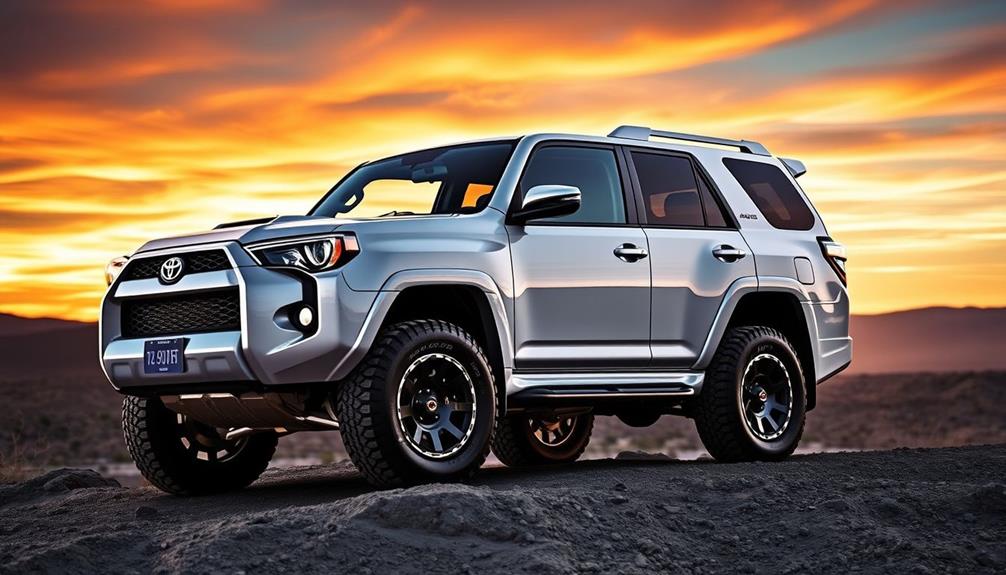
Tuning your Toyota 4Runner Limited can truly elevate its performance. Start by considering an ECU flash, which can add over 20 rear-wheel horsepower and improve throttle response. Regular maintenance, like cleaning the throttle body and ensuring proper tire pressure, also plays an essential role in maximizing performance. Don't forget about upgrades like cold air intakes and enhanced suspension systems to improve handling and efficiency. Keep in mind compatibility issues with certain models that may require standalone tuning solutions. Want to reveal the full potential of your 4Runner? There's plenty more to explore to take your SUV to the next level.
Key Takeaways
- Tuning devices like ECU flashing can significantly enhance the Toyota 4Runner's performance, increasing horsepower and improving throttle response.
- Regular maintenance, including throttle body cleaning and spark plug replacement, is essential for optimal engine performance and fuel efficiency.
- Aerodynamic modifications, such as spoilers and air dams, can reduce drag and improve fuel economy, enhancing overall performance.
- Upgraded suspension and performance exhaust systems can boost handling stability and airflow, respectively, leading to a more powerful driving experience.
- Utilizing diagnostic tools and professional tuning services can help maximize the performance potential of your 4Runner while ensuring reliable operation.
Understanding Tuning Devices
When it comes to enhancing your Toyota 4Runner's performance, understanding tuning devices is vital. These tools can promise significant improvements, but it's important to know that not all devices deliver as expected. Some tuning devices may even reduce your fuel efficiency by pushing your vehicle outside the ECU's ideal specifications.
Additionally, be aware that some 4Runner models may have locked ECUs, meaning you'll need to take into account full stand-alone systems for any modifications.
For the 2015-2018 Toyota 4Runner, there are specific tuning solutions available, and the market is evolving to support more ECU IDs. One effective method is ECU flashing, like the VR tune process, which can yield over 20 rear-wheel horsepower and markedly enhance throttle response and drivability.
However, when evaluating these performance gains, remember to factor in drivetrain loss—typically around 20% on a Mustang dyno. This means the actual horsepower increase may be less than what the tuning device promises.
Essential Maintenance Tips

To keep your Toyota 4Runner running at its best, consistent maintenance is vital. Start by regularly cleaning the throttle body; this can markedly enhance engine performance and improve fuel economy. An optimized throttle body guarantees your engine breathes well, leading to better fuel efficiency.
Don't forget to inspect and replace any vacuum hoses that show signs of cracks or rigidity. These hoses play an essential role in preventing air leaks, which can hinder engine operation.
Additionally, cleaning the air intake system maintains proper airflow, another key factor for efficient engine performance.
Pay attention to your spark plugs, too. Replacing worn spark plugs can lead to a smoother engine operation and better mileage.
If you notice any performance issues, consider that a worn throttle body might be the culprit. Replacing it can greatly improve your fuel economy.
Compatibility and Limitations

When tuning your Toyota 4Runner, you need to take into account ECU locking issues that can limit your options.
Not all models can be tuned easily, so you'll want to explore vehicle-specific solutions for the best results.
Knowing these factors can help you make informed decisions about your tuning journey.
ECU Locking Issues
The Toyota 4Runner's ECU locking issues pose significant challenges for enthusiasts looking to boost performance through tuning. Many models, particularly from 2015 to 2018, come with locked ECU systems that restrict your tuning options without extensive modifications.
If you're aiming to achieve tuning on these locked systems, you might need a full stand-alone ECU, which can be both complex and costly.
Local tuners vary in expertise and equipment, impacting the effectiveness of tuning solutions available for your 4Runner. While specific tuning solutions are continuously being developed to support a wider range of ECU IDs for these models, compatibility remains limited. This means you may end up facing compatibility issues during your tuning journey.
Moreover, if your ECU is locked and you experience issues, you might see the Check Engine Light activate, signaling potential problems. Using a code reader can help diagnose these issues, but it doesn't resolve the underlying ECU limitations.
Proper tuning can lead to significant performance gains, but understanding the potential ECU locking issues is essential for optimizing your vehicle's capabilities. Be prepared for a bit of a challenge on your tuning adventure!
Vehicle-Specific Tuning Solutions
Steering through vehicle-specific tuning solutions for the Toyota 4Runner requires a clear understanding of compatibility and limitations, especially given the secured ECU systems in many models.
For your 2015-2018 4Runner, tuning options are specifically developed to address various ECU IDs, allowing for brand new performance enhancements. However, some vehicles, particularly those with secured ECUs, may not be tuneable without a full stand-alone system.
It's essential to choose local tuners wisely since their expertise can greatly impact the quality of the tuning solutions provided. A skilled tuner can help access the full power of your 4Runner, potentially increasing rear-wheel horsepower by over 20 and providing better throttle response throughout the rev range.
Importantly, the ECU flash process for the 2018 Toyota 4Runner TRD Pro is a quick five-minute procedure utilizing the OBD2 port, ensuring you can enhance performance without extensive modifications.
Improving Aerodynamics

Boosting the Toyota 4Runner's aerodynamics can greatly enhance your driving experience by reducing drag and improving fuel efficiency. One effective way to achieve this is by installing modifications like a rear spoiler or a front air dam. These components help redirect airflow, minimizing turbulence and lowering the drag coefficient, especially during high-speed driving.
In addition to these modifications, you can also consider utilizing smoother, more streamlined body kits. These kits can notably improve airflow around your SUV, potentially increasing your miles per gallon by a measurable percentage.
Don't forget about your tires; properly adjusted tire pressure and low-rolling-resistance tires can further optimize your vehicle's performance on the road.
Regular maintenance is essential, too. Keeping the undercarriage clean prevents dirt and debris buildup that could disrupt airflow, thereby enhancing your vehicle's aerodynamic efficiency.
Recommended Automotive Products
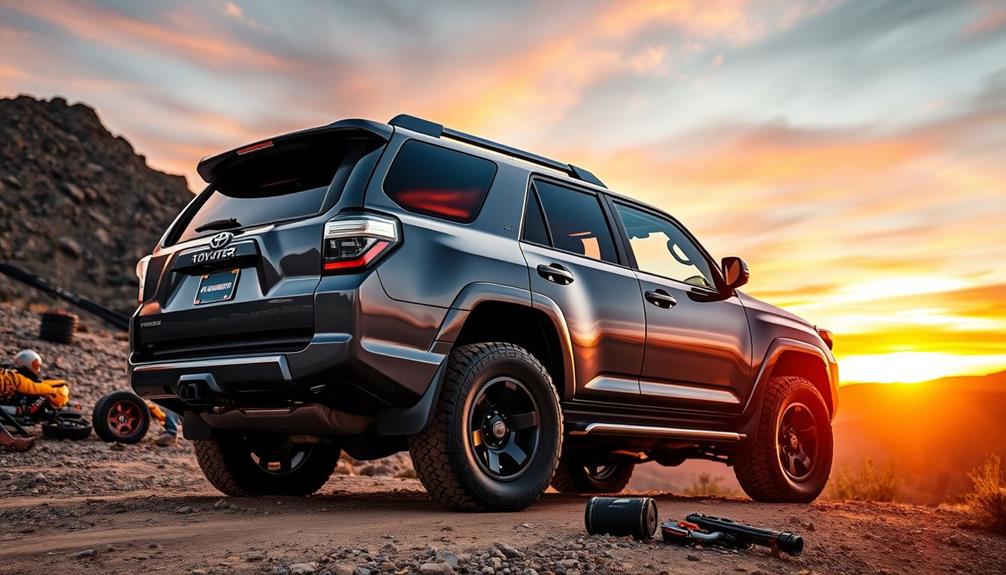
When it comes to enhancing your Toyota 4Runner's performance and efficiency, selecting the right automotive products makes all the difference. Let's check some recommended products that can help you get the most out of your SUV.
| Product | Price |
|---|---|
| Bluetooth OBD II Scanner | $14.95 |
| Performance Tool Torque Wrench | $7.48 |
| Monroe Shocks & Struts | $23.56 |
| Throttle Body Cleaning | N/A |
| Cold Air Intakes & Specialty Filters | N/A |
The Bluetooth OBD II Scanner is a must-have for diagnosing performance issues, allowing you to monitor engine parameters effectively. While Cold Air Intakes are popular, they can disrupt engine operation and may hurt fuel efficiency, so consider this carefully. Regular maintenance, like throttle body cleaning, can greatly enhance engine performance and fuel mileage.
Additionally, the Performance Tool Torque Wrench guarantees proper installation of aftermarket parts, vital for overall vehicle performance. Upgrading to Monroe Shocks & Struts can also improve handling and ride quality. By incorporating these products, you'll see tangible improvements in your 4Runner's performance.
ECU Flash Process and Benefits

Upgrading your Toyota 4Runner's performance can really kick things up a notch, and one of the most effective ways to do this is through the ECU flash process. This quick and straightforward method takes about five minutes and connects to your vehicle's OBD2 port for easy access.
Let's see what benefits you can expect:
- Increased Power: Gain over 20 rear-wheel horsepower and enhance torque.
- Improved Throttle Response: Enjoy a more responsive driving experience.
- Enhanced Drivability: Make daily commutes and spirited drives much more enjoyable.
- Easy Access to Tune Files: Download from Vivid Racing's website with just a few clicks.
- Smoother Performance: Experience a nice and smooth ride throughout the entire rev range.
Initial testing showed a stock output of 156 rear-wheel horsepower and 180 ft-lb of torque. After the ECU flash, dyno testing confirmed significant improvements, making your 4Runner a true performance powerhouse.
With these enhancements, you'll feel the difference on the road, transforming your driving experience into something truly special.
Don't wait—unlock your SUV's potential today!
Frequently Asked Questions
How Do I Get More Power Out of My 4runner?
To get more power out of your 4Runner, consider a VR tune ECU flash, upgrade to a cold air intake, and regularly maintain your engine. These steps can enhance performance while improving throttle response and drivability.
What Is the Weakness of the 4runner?
The 4Runner's main weakness is its relatively low horsepower and heavy weight, which affects acceleration and agility. You might find it less responsive than other SUVs, especially when tackling on-road performance challenges.
How Long Will a 4runner Limited Last?
With regular maintenance, your 4Runner Limited could easily last over 200,000 miles. Many owners report 15-20 years of reliable service, proving it's an investment that stands the test of time and adventure.
What Makes a 4runner Limited?
A 4Runner Limited stands out due to its luxurious features, like leather upholstery and advanced tech. You'll appreciate the comfort, safety enhancements, and off-road capabilities that make it a versatile choice for any adventure.
Conclusion
In summary, tuning your Toyota 4Runner Limited can truly transform it into a performance powerhouse. With the right tuning devices and maintenance, you'll not only boost its power but also enhance your driving experience. So, why settle for ordinary when you can release extraordinary performance? By investing in the right products and understanding the tuning process, you're well on your way to enjoying an SUV that stands out on the road. Get ready for an exhilarating ride!
Jimmy is a dedicated drift and drag racing enthusiast who deeply understands the unique tuning requirements for these high-octane sports. His expertise covers everything from drift suspension setups to drag racing launch control systems, providing our readers with the knowledge they need to compete at the highest levels. Jimmy’s passion for these motorsports shines through in his detailed articles and practical recommendations.
-

 Hybrid Tuning3 months ago
Hybrid Tuning3 months agoHonda Civic Hybrid Tuning: Unlocking Maximum Efficiency and Performance
-

 Hybrid Tuning3 months ago
Hybrid Tuning3 months agoPorsche Cayenne E-Hybrid Tuning: Unleashing the Beast Within the Luxury SUV
-

 Audi Tuning3 months ago
Audi Tuning3 months agoChip Tuning Audi: How to Unlock Extra Power Instantly
-

 Automotive DIY and Professional Guides3 months ago
Automotive DIY and Professional Guides3 months agoWhen Is Car Tuning Required? Signs It’s Time for an Upgrade
-

 Audi Tuning3 months ago
Audi Tuning3 months agoAudi A3 Tuning: Elevate Your Compact Car’s Performance
-

 Hybrid Tuning3 months ago
Hybrid Tuning3 months agoInfiniti Q50 Hybrid Chip Tuning: Enhance Performance With Precision Tuning
-

 Hybrid Tuning3 months ago
Hybrid Tuning3 months agoNissan Altima Hybrid Tuning: Upgrade Your Sedan for Maximum Efficiency
-

 Hybrid Tuning3 months ago
Hybrid Tuning3 months agoCube Reaction Hybrid Tuning: Get the Most Out of Your Electric Bike




























